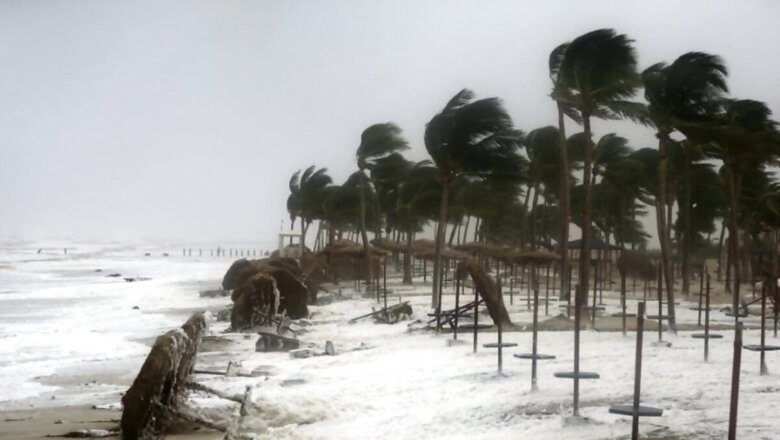
views
As the Central Bureau of Investigation (CBI) gets down to probe the Balasore train accident, more and more heart-warming stories of railway personnel, country’s disaster management and relief forces, local residents, the Odisha State Disaster Management Authority (OSDMA), and state fire service personnel, who worked day and night in rescue and relief operation, are emerging.
Set up by the Odisha government immediately in the aftermath of the devastating October 1999 ‘super’ cyclone, the OSDMA has since garnered respect and accolades from governments and people across the country.
The devastating 1999 cyclone caused widespread destruction in Odisha, claiming nearly 10,000 lives, and causing damage worth billions of rupees. The calamity had brought the entire eastern state to a halt. The disaster also wrecked Congress’ political fortune in the state. The sitting Congress chief minister, Giridhar Gamang, had to resign. In the elections that followed in February 2000, the BJD-BJP alliance, led by Naveen Patnaik, secured the people’s mandate.
Headquartered in the capital city of Bhubaneswar, the state disaster body operates under the Revenue and Disaster Management department of the state. It was one of the first official responders in the tragic rail disaster on Friday.
Odisha being a disaster-prone state due to its proximity to the Bay of Bengal, the need for such a professionally trained workforce was even more imperative. The October 1999 disaster had, moreover, exposed the limitation of the civic administration in addressing the unique challenges such disasters bring to the fore.
“They (the Odia people) were victims of one of the deadliest super cyclones in India, resulting in over 10,000 casualties in 1999. Confronted with this tragedy, both the people and the government learned valuable lessons and implemented changes in their functioning and lives,” said Dr Anil Kumar Gupta, Professor at the National Institute of Disaster Management (NIDM) in New Delhi, explaining why Odisha excels at managing both natural and man-made disasters.
Not only were these critical lessons documented on paper, but they were also taken to the grassroots, reaching the districts and villages.
The new authority faced its initial challenge in transforming the management of post-disaster work processes. Previously, search and rescue operations were carried out through collaboration between the Special Relief Commissioner, State Fire Services, and State Port Organization. However, this approach proved cumbersome, with bureaucratic obstacles hindering the pace of relief and rescue work. To overcome this, OSDMA unified the processes, streamlining communication and enhancing coordination among stakeholders.
Furthermore, to address the requirement of a skilled team with advanced tools for supporting the civil administration in search, rescue, and relief operations, the specialised Odisha Disaster Rapid Action Force (ODRAF) was established in 2001.
It is the first force of its kind in the country and comprises 20 units drawn from different forces, such as the Odisha Special Armed Police, Armed Police Reserve, India Reserved Battalion, and Specialized India Reserve Battalion. Active units of ODRAF are stationed in 20 districts of the state.
The Odisha government views disasters as a challenge, especially natural calamities, with a stated aim of achieving ‘zero casualties’. They not only document it on paper but also implement the mitigation process on the ground level with equal enthusiasm, which has made Odisha a role model in disaster management, explained a disaster expert who has worked closely with the state government.
“Not only Odisha, but many other smaller states could also provide valuable lessons in managing disasters. They can also showcase good examples. However, Odisha has excelled by streamlining its management and integrating it into its processes,” said Dr Gupta of NDMA. He added that from the local-level Talukdar to the Chief Minister, everyone takes disaster management seriously.
The skills matrix of ODRAF personnel encompasses various emergency responses, such as water rescue, collapsed structure search and rescue, relief line clearance, transportation, communication, and casualty management, among others.
To speed up the deployment in urgent situations, telephonic requests received quickly acted upon.
The state disaster authority is also recognised for its ability to learn from criticism, act swiftly on suggestions, and show eagerness to acquire new knowledge that could enhance their response capabilities, added Dr. Gupta.
The ODRAF units are equipped with 66 types of sophisticated equipment necessary for effective disaster management. These include road clearing equipment, branch cutters, tree pruners, concrete cutters, RCC cutters, boats, inflatable tower lights, generators, forklifts, hydraulic rescue kits, collapse structure search and rescue (CSSR) kits, medical first responder (MFR) kits, ambulances, and other state-of-the-art instruments critical for handling emergencies.
These instruments, training, and extensive past experience proved invaluable when the team was tasked with rescuing the passengers of the ill-fated trains. Their courageous efforts, as reported in The Hindu and quoted by Satyabrata Sahu, Special Relief Commissioner, saved 1200 lives.
In addition to the disaster management authority, the Odisha Fire Service plays a unique role by being responsible for both conventional fire-fighting and disaster response. Following the 1999 cyclone disaster, the state government made a policy decision to transform each Fire Station into a multi-hazard disaster response unit while retaining its core mandate of fire-fighting and rescue operations. This strategic move has greatly strengthened the state government’s capacity in disaster management.
“Because of the past experience, Odisha has gained from managing disasters and infrastructure fire and cutters, hydraulic lifter, massive diesel generators, lighting equipment and fast-moving ambulances, a large number of lives could be saved in the worst train mishap in Odisha,” the State Industry Secretary Hemant Sharma was quoted as saying.
It is no surprise that the commendable efforts of both ODRAF and the state fire service during the crisis caught the attention of Prime Minister Narendra Modi.
“I commend each and every person belonging to the teams of railways, NDRF, ODRAF, local authorities, police, fire service, volunteers and others who are working tirelessly on the ground and strengthening the rescue ops. Proud of their dedication,” the PM had tweeted.
No wonder, the heroic efforts of Odisha’s disaster and fire services have ensured that the state does not suffer the same fate as in 1999. Whether facing cyclones like Phailin (2013), Titli (2018), Fani (2019), Bulbul (2019), or Amphan (2020), the team has worked hand in hand to minimise human casualties.
The Odisha team has also made significant contributions outside the state in times of crisis. They are in high demand for post disaster assistance. They were called upon to assist during the 2018 Kerala floods, the Meghalaya mines rescue (2018), Cyclone Amphan in West Bengal (2020), and relief and rescue operations following Cyclone Hudhud in Andhra Pradesh (2014).
“The NDFR personnel are skilled in their work, but they come from different states. To effectively interact and coordinate with the locals, one needs to know the local language and understand their habits. Therefore, no other force can match the resilience of a local team,” explains Dr. Gupta. Secondly, the top government disaster management officials keep a keen eye for details, he added.
“Officials both at the top and bottom are in sync here. The teams working on the ground have been empowered to make decisions based on their needs and the situation. There is no top-down approach. Such devolution of power also fosters accountability at the lowest level in disaster management,” Dr. Gupta said.
Deepak Singh, Lead Disaster Risk Management Specialist at the World Bank, had said in an interview after Cyclone Fani had wreaked havoc on the coastal areas of Odisha and West Bengal in May 2019 that the state has a “great community outreach system” through which people are being alerted on time. The system has a network of 450 cyclone shelters and there is a robust mechanism for the maintenance of the cyclone shelters, each having a maintenance committee where youth have been involved and trained for search and rescue, first aid medical attention, and for providing cyclone warnings, he added.



















Comments
0 comment